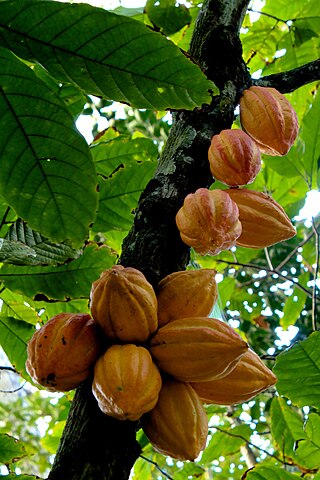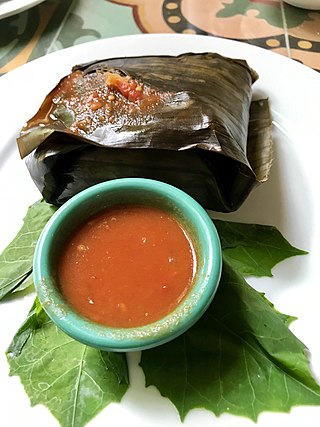
Chocolate is a food made from roasted and ground cocoa beans that can be a liquid, solid, or paste, either on its own or as a flavoring in other foods. The cacao tree has been used as a source of food for at least 5,300 years, starting with the Mayo-Chinchipe culture in what is present-day Ecuador. Later, Mesoamerican civilizations consumed cacao beverages, of which one, chocolate, was introduced to Europe in the 16th century.

The cocoa bean, also known simply as cocoa or cacao, is the dried and fully fermented seed of Theobroma cacao, the cacao tree, from which cocoa solids and cocoa butter can be extracted. Cacao trees are native to the Amazon rainforest. They are the basis of chocolate and Mesoamerican foods including tejate, an indigenous Mexican drink.

Theobroma cacao is a small evergreen tree in the family Malvaceae. Its seeds - cocoa beans - are used to make chocolate liquor, cocoa solids, cocoa butter and chocolate. Although the tree is native to the tropics of the Americas, the largest producer of cocoa beans in 2022 was Ivory Coast. The plant's leaves are alternate, entire, unlobed, 10–50 cm (4–20 in) long and 5–10 cm (2–4 in) broad.

Hot chocolate, also known as hot cocoa or drinking chocolate, is a heated drink consisting of shaved or melted chocolate or cocoa powder, heated milk or water, and usually a sweetener. It is often garnished with whipped cream or marshmallows. Hot chocolate made with melted chocolate is sometimes called drinking chocolate, characterized by less sweetness and a thicker consistency.

Adelia barbinervis is a species of flowering plant in the family Euphorbiaceae that is native to southern Mexico and northern Central America. The Huastec Maya cultivated the plant as a famine food.
Tascalate is a chocolate drink made from a mixture of roasted maize, roasted cocoa bean, ground pine nuts, achiote and sugar or panela, very common in the Mexican state of Chiapas.

The ancient Aztecs employed a variety of entheogenic plants and animals within their society. The various species have been identified through their depiction on murals, vases, and other objects.

The history of chocolate dates back over 5,000 years, when the cacao tree was first domesticated in present-day southeast Ecuador. Soon introduced to Mesoamerica, it gained cultural significance as an elite drink among different cultures, including the Mayans and Aztecs. Cacao was extremely important: considered a gift from the gods, it was used as a currency as well as medicinally and ceremonially. Chocolate was often associated with the heart, and was believed to be psychedelic. It is unclear when chocolate was first drunk, and there is evidence of Mesoamerican groups drinking an alcoholic drink made by fermenting the pulp around cacao seeds.

Ancient Maya cuisine was varied and extensive. Many different types of resources were consumed, including maritime, flora, and faunal material, and food was obtained or produced through strategies such as hunting, foraging, and large-scale agricultural production. Plant domestication concentrated upon several core foods, the most important of which was maize.

Tejate is a non-alcoholic maize and cacao beverage traditionally made in Oaxaca, Mexico, originating from pre-Hispanic times. It remains very popular among the indigenous Mixtec and Zapotec peoples, especially in rural areas. It is also very popular in Oaxaca and the surrounding regions. Principal ingredients include toasted maize, fermented cacao beans, toasted mamey pits (pixtle) and flor de cacao. These are finely ground into a paste. The paste is mixed with water, usually by hand, and when it is ready, the flor de cacao rises to the top to form a pasty foam. It can be served as-is or with some sugar syrup to sweeten it. The drink is served cold.
The Mopan people are an Indigenous, sub-ethnic group of the Maya peoples. They are native to regions of Belize and Guatemala.

Mexican tea culture is known for its traditional herbal teas which are reputed to have medicinal properties. In recent decades, imported tea beverages have also become popular in Mexico. Mexican tea recipes have grown in popularity beyond Mexico as well.

Oaxacan cuisine is a regional cuisine of Mexico, centered on the city of Oaxaca, the capital of the eponymous state located in southern Mexico. Oaxaca is one of the country's major gastronomic, historical, and gastro-historical centers whose cuisine is known internationally. Like the rest of Mexican cuisine, Oaxacan food is based on staples such as corn, beans, and chile peppers, but there is a great variety of other ingredients and food preparations due to the influence of the state's varied geography and indigenous cultures. Corn and many beans were first cultivated in Oaxaca. Well-known features of the cuisine include ingredients such as chocolate, Oaxaca cheese, mezcal, and grasshoppers (chapulines), with dishes such as tlayudas, Oaxacan-style tamales, and seven notable varieties of mole sauce. The cuisine has been praised and promoted by food experts such as Diana Kennedy and Rick Bayless and is part of the state's appeal for tourists.

Theobroma bicolor, known commonly as the mocambo tree, jaguar tree, balamte, or pataxte, among various other common names, is a tree in the genus Theobroma, which also contains the better-known Theobroma cacao. It is found in Central and South America, including stretches of the Amazon rainforest in Brazil, Colombia, Ecuador, and Peru.

Cola nitida is a species of plant belonging to the family Malvaceae.

The Jardín Etnobotánico de Oaxaca is a botanical garden in Oaxaca City, Mexico. It occupies 2.32 acres of land adjacent to the Church of Santo Domingo. It is administered by the state government of Oaxaca.
The chocolate industry in the Philippines developed after the introduction of the cocoa tree to Philippine agriculture. The growing of cacao or cocoa boasts a long history stretching from the colonial times. Originating from Mesoamerican forests, cacao was first introduced by the Spanish colonizers four centuries ago. Since then the Philippine cocoa industry has been the primary producer of cocoa beans in Southeast Asia. There are many areas of production of cacao in the Philippines, owing to soil and climate. The chocolate industry is currently on a small to medium scale.
Pixtle is the name given to the processed seed of the mamey sapote, a tropical tree native to Mexico and Central America. The seed is encased within the mamey sapote fruit, which is known for its sweet, creamy flesh. The term "pixtle" comes from the Nahuatl word "pitztli," meaning "bone" or "seed."














